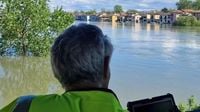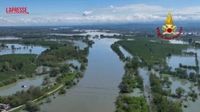On April 18, 2025, the Ticino River overflowed in Pavia, Italy, leading to significant flooding in the area. The overflow was triggered by heavy rains that had been affecting the region, causing streets to transform into rivers and trapping residents in their homes. Rescue operations were promptly initiated, with firefighters and local authorities using boats to navigate the flooded streets and assist those in need.
The most affected area was the Borgo Ticino neighborhood, particularly along Via Milazzo, which was completely submerged. Reports indicated that the river had entered basements and ground floors of homes, prompting urgent evacuation efforts. Firefighters, in collaboration with the Civil Protection and law enforcement, worked tirelessly to evacuate dozens of residents using rafts and inflatable boats. They also delivered essential goods to those stranded and helped individuals recover personal belongings from their flooded homes.
According to local officials, approximately ten families received assistance during the rescue operations. A command unit was established at Piazzale Ferruccio Ghinaglia, serving as a coordination point for all emergency services involved in the response efforts. Municipal councilor Rodolfo Faldini assessed the situation, stating, "The situation is serious, but under control." He noted that while the water levels were alarming, the rate of the river's growth had begun to slow down, decreasing from 15 centimeters per hour earlier in the day.
Despite the challenging circumstances, residents were advised to stay in their homes and move to upper floors if necessary, as no mass evacuations were ordered. The mayor of Pavia, Michele Lissia, issued an ordinance prohibiting pedestrian and vehicular traffic on Via Milazzo and Via Trinchera until the emergency situation was resolved. This measure aimed to ensure the safety of both residents and rescue workers.
As the day progressed, officials expressed cautious optimism that the situation might improve. They hoped that the peak of the flood would pass soon, particularly as the flow from the Po River, which was also under scrutiny due to rising water levels, would lessen the complexity of the confluence between the two rivers at the Becca Bridge.
While the immediate focus remained on the rescue operations in Pavia, authorities were also monitoring the potential impact of the Po River flood in the Piacenza area. A red alert was issued for April 19, 2025, as the peak of the Po River flood was expected to arrive in the evening hours, continuing into the night. Emergency services were on high alert, ready to respond to any developments.
The situation in Pavia highlights the broader challenges faced by many regions in Italy due to extreme weather events. The recent heavy rainfall has raised concerns about the capacity of local infrastructure to handle such deluges, prompting discussions about future preparedness and mitigation strategies.
In a related incident, an investigation was launched into the collapse of the Ponte dei Nori bridge in Valdagno, which occurred during the adverse weather conditions. Tragically, two individuals—a father and son—lost their lives when the bridge gave way while they were crossing in their vehicle. The authorities are currently looking into the circumstances surrounding this disaster, with charges of culpable disaster being considered.
As Pavia and surrounding areas continue to deal with the aftermath of the flooding, the community is coming together to support one another. Local organizations and volunteers are stepping up to provide assistance to those affected, including food, shelter, and emotional support. The resilience of the community is evident as they navigate this challenging time.
In conclusion, the flooding in Pavia serves as a stark reminder of the impact of climate change and the importance of effective disaster response systems. As the water levels begin to recede, the focus will shift towards recovery and rebuilding, ensuring that lessons learned from this event will help safeguard the community against future flooding.









